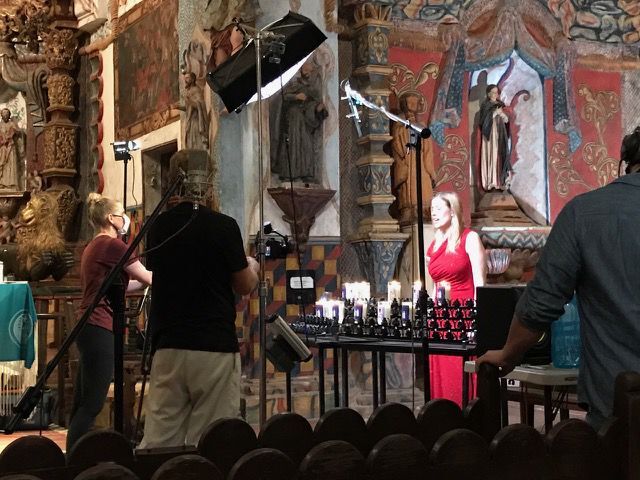In a year when traditions have been turned topsy turvy and it’s not possible for people to come to the Mission San Xavier del Bac for the annual Patronato’s Christmas at San Xavier Concert Series, the Patronato has made it possible for the mission to come to the people.
For the first time in 24 years, the typically sold-out concert can be enjoyed from anywhere in the world through Dec. 31 online at patronatosanxavier.org with a one-time contribution in any amount.
“When we realized in April that the concert was not likely to happen due to COVID, we decided to craft a concert where the mission would become the star: We wanted people to experience the beauty that is the Mission San Xavier. Many describe it as the most stunning building in all of Arizona and the finest example of Mexican Baroque architecture in the country,” said Miles Green, executive director of the Patronato San Xavier, a nonprofit dedicated to the ethical conservation and preservation of the historic mission. “We sometimes take it for granted because it is in our back yard, but people are increasingly seeing it as a cultural site of international significance.”
In fact, Green decided the best way to promote the mission, at 1950 W. San Xavier Road, and the beloved concert was through art itself — the art of film. He brought that vision to fruition through a collaboration with Dan Duncan, a filmmaker who owns a private production company and whose credits include the PBS documentary, “The Desert Speaks” and the series “In the Americas with Dave Yetman.”
Instead of a simple Zoom concert, Miles created a storyline that incorporates performances from traditional contributors such as the Tucson Boys and Girls Choruses and award-winning soloists into the 33-minute production showcasing the mission.
“We were able to bring together elements that people have come to expect every year, and woven in with the performances are stunning drone shots of interior spaces that are typically closed to the public — the choir loft, belfry, sacristy, and beautiful shots of the high altar and transepts. These wonderful interior shots put the mission into a sphere many people wouldn’t have imagined,” said Green.
Duncan said he was honored to engineer the stunning, never-before-seen footage captured by the drone.
“It is such a special place: You never tire of the beauty and splendor. Every time you go in to the mission, it is an “Oh, wow!” moment, and to see the nooks and crannies that a normal visitor would never have a glimpse into was quite rewarding to us. We wouldn’t have had that birds-eye view had we not had the drone up in the lofts exploring the corners and enhancing the 3D space of the mission,” he said.
Duncan credits Green with creating a story that allowed for exploration of three-dimensional spaces in juxtaposition with still shots to accommodate challenges such as social distancing during the making of the one-of-a-kind show.
The story follows Father Bill Minkel, the parish priest at the mission, and Susie Moreno, a conservator apprentice, as they enter the church together; the concert progresses for the audience of two.
To adhere to pandemic protocol while still capturing the extraordinary acoustics of the mission, recordings were completed with performers socially distanced and filming was done with performers lip-syncing. The footage was edited later to simulate a continuous live performance featuring holiday favorites such as “Hark the Herald Angels Sing,” “Ave Maria,” “Joy to the World,” “Oh Tannenbaum,” “Silent Night” and many more.
“This was a very complex project and was quite the challenge since all of the safety factors needed to be well in place and we wanted to it to seem as if it were happening in a normal time,” Duncan said. “Miles was ingenious in pulling together a story line to make this more than a virtual performance.”
Ultimately, the team is gratified that the project is promoting awareness about the mission during a year that has been particularly trying for nonprofits that support architecture, the arts and culture.
Green said the pandemic has impacted the Patronato’s docent program, which has been suspended since March, cutting revenue from visitors and guests.
Additionally, under normal circumstances, ticket sales generated by concerts account for 20% of operating expenses; traditionally the seven-performance Christmas Concert Series nets nearly $200,000 in four days.
“Not only is it a huge fundraiser, but it brings all of the volunteer team together, which is very special. We are hoping to recognize at least half of the regular funds through donations in lieu of people attending the concerts. Of course, if the virtual concert goes viral, we will do particularly well and that is our hope. An unexpected consequence of the virtual concert is that many people are accessing our website and we are gathering names of many new people for whom our conservation cause seems to be resonating,” said Green.
In the upcoming year, the Patronato plans to embark on conservation of additional sets of the original mission doors, preservation of fragile mural paintings inside the church and completion of the east tower project. The ongoing conservation efforts have a hefty price tag: The cost of projects that will launch in 2021 is about $1 million, and Green said the momentum of the virtual concert will impact whether that goal can be reached.
Ultimately, Green emphasized that conservation of the mission is a gift of architecture, culture and history.
“While there are oppressive needs due to the COVID crisis, the Mission represents the oldest European building in our state and historic conservation of buildings of this significance can’t wait. Clearly when you are dealing with a building that is 225 years old, the needs are enormous: The conditions here in Arizona are extremely hard on a building like this and the Patronato’s goal is to preserve it for future generations,” Green said.





